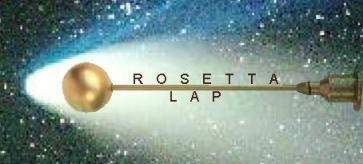
IRF Uppsala
...English
...Svenska
Space Plasma Physics
...English
...Svenska
Rosetta (English)
...Home
...Mission
...Timeline
...Science
...LAP team
...RPC team
Rosetta (svenska)
...Hem
...Projektet
...Tidtabell
...Vetenskap
...LAP-gruppen
...RPC-gruppen
...Galleri
Tech pages
Team pages (restricted)
| INSTITUTET FÖR RYMDFYSIK | Space Plasma Physics programme, UPPSALA |
 |
|
| Swedish Institute of Space Physics | (59o50.272'N, 17o38.786'E) |
 |
Rosetta is an ambitious project catching up with a comet, following it in its orbit for two years (2014-2016), putting a lander (Nov 2014) and finally itself onto the surface of the comet nucleus. Our onboard space weather station LAP was active from start to end! |
| Back to Rosetta LAP home page |
The Rosetta mission
The basic goal of Rosetta is to study the origin of comets, the relationship between cometary and interstellar material and its implications with regard to the origin of the Solar System. A full description of the project can be found on the ESA web pages for Rosetta, http://science.esa.int/rosetta/. Unique features of the mission are:- The long time, more than a year, to be spent around the comet. Previous missions, like Giotto or Stardust, have only made brief flybys: we will monitor the dynamics of the comet and its environment for more than a year.
- The lander, which will investigate the cometary nucleus in detail.
- Several aspects of the spacecraft and payload technology, among them using solar panels for generation of electric power as far as 5 AU (five times the sun-earth distance) from the sun.
Why is the journey so long? To follow a comet for a long time, you have to catch up with it. Relying just on rockets to give us the velocity we need would not do: almost all the spacecraft would have to be taken up by the large amount of fuel needed for such an operation. Instead we rely on planetary flybys, where we steal some energy from the planet we fly by. Rosetta needs no less than four flybys, three of Earth (in 2005, 2007 and 2009) and one of Mars (in 2007), to get the necessary speed. The route to the comet therefore is long and complex, and takes a lot of time -- see figure below.

Rosetta interplanetary trajectory (Copyright: ESA).
Green circle: Earth orbit
Red circle: Mars orbit
White ellipse: Comet orbit
(1) Launch, 2 March 2004.
(2) First Earth swingby, 3 March 2005.
(3) Mars swingby, 26 February 2007
(4) Second Earth swingby, 14 November 2007
(5) Asteroid Steins flyby
(6) Third Earth flyby, 11 November 2009
(7) Asteroid Lutetia flyby
(8) Arriving at the comet in 2014